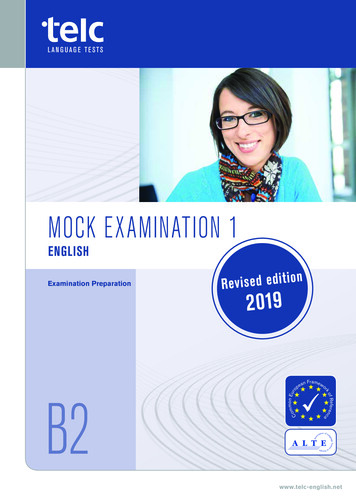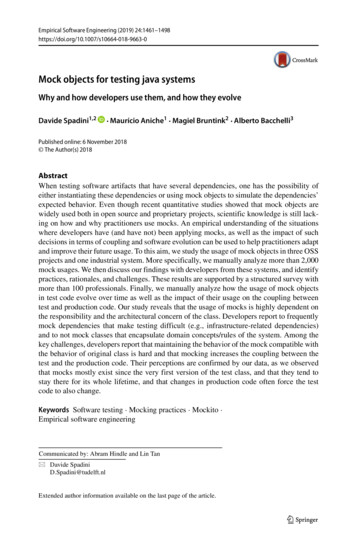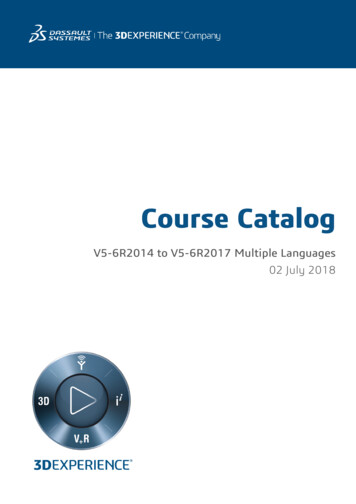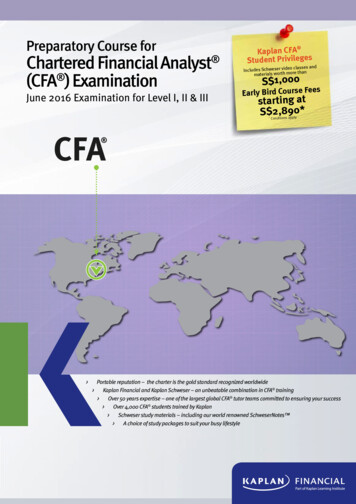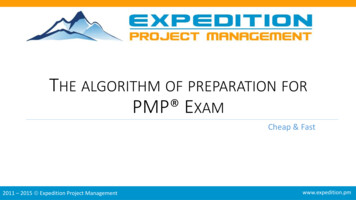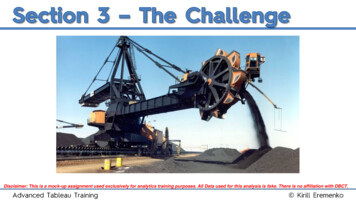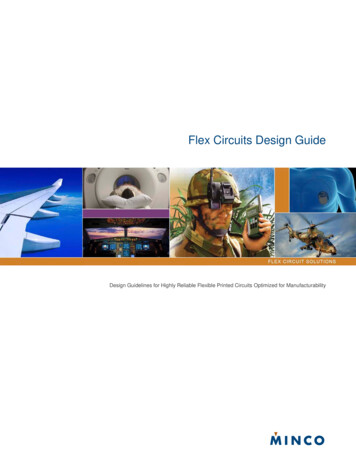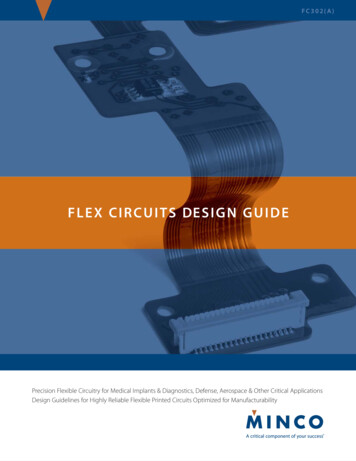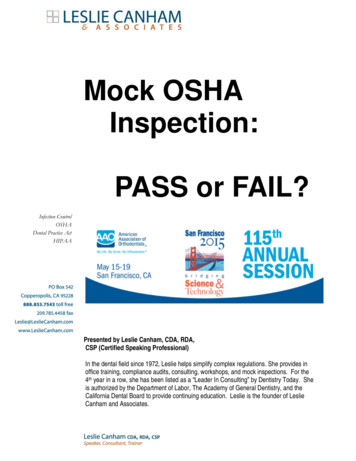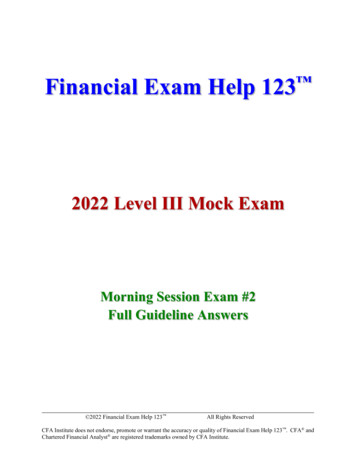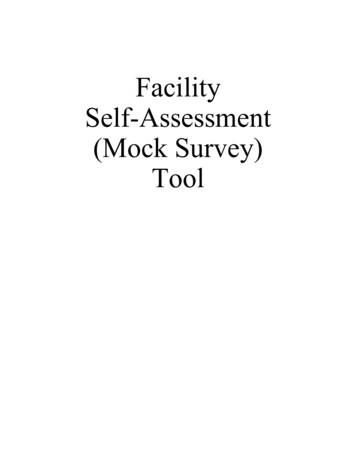
Transcription
FacilitySelf-Assessment(Mock Survey)Tool
SECTION 5 - FACILITY SELF-ASSESSMENT (MOCKSURVEY TOOLS)Facility Self-Assessment - Mock surveys are an opportunity to look at systems,procedures and processes of care and to identify potential survey-risk areas.Mock surveys should be performed on a scheduled basis and shared withnursing home staff. The most important part of the survey process is what youdo after it is over with the results. F-tags are used in this section. Be advisedthat CMS makes revisions to the F-tags on a regular basis.SECTIONAdministrationArticle: Mock Survey: An Important ComponentSelf-Assessment/Mock SurveyGuide to F-Tag NumbersLong-Term Care Survey Process (LTCSP) Procedure GuideSurvey Scope & Severity GridOffsite Preparation WorksheetMapping for Initial Pool Care AreasTags Not Mapped to a Care AreaMandatory Facility TaskCMS 20053 Dining ObservationCMS 20054 Infection Prevention, Control, & ImmunizationsCMS 20055 Kitchen ObservationCMS 20052 Beneficiary Protection Notification ReviewCMS 20056 Medication Administration ObservationCMS 20089 Medication Storage and LabelingCMS 20058 QAA & QAPICMS 20057 Resident Council InterviewCMS 20062 Sufficient & Competent Nurse StaffingFirst Impressions ChecklistAdministration ChecklistContract Book ChecklistPersonnel File ChecklistCritical Element PathwaysCMS-20059 AbuseCMS-20063 Personal FundsCMS-20091 Extended SurveyCMS-20130 NeglectEnvironmentPhysical Plant Rounds-Initial TourFire Drill GridCMS-20061 Environmental ObservationsUpdated March 2022PAGE 8-169170-173174-177178-183185-205206207-210
NursingMDS Audit ToolChart Audit ToolCMS-20066 Activities of Daily LivingCMS-20067 Behavioral-EmotionalCMS-20068 Urinary Catheter or UTICMS-20069 Communication-SensoryCMS-20071 DialysisCMS-20072 GeneralCMS-20073 Hospice and End-of-LifeCMS-20074 DeathCMS-20075 NutritionCMS-20076 Pain ManagementCMS-20077 Physical RestraintsCMS-20078 Pressure UlcerCMS-20080 Rehab and RestorativeCMS-20081 Respiratory CareCMS-20082 Unnecessary MedicationsCMS-20092 HydrationCMS-20093 Tube FeedingCMS-20120 Positioning, Mobility, ROMCMS-20123 HospitalizationCMS-20125 Bladder and Bowel IncontinenceCMS-20127 AccidentsCMS-20131 Resident AssessmentCMS-20132 DischargeCMS-20133 Dementia CareMapping for All AreasPsychosocial Severity GuideDietaryDietary ObservationsMonthly Meal Quality ReviewMonthly Sanitation/Infection Control ReviewMeal Audit ToolCMS-20075 NutritionSocial ServicesLTCSP Resident Interview Care AreaLTCSP Resident Representative Care AreaLTCSP Resident Observation Care AreaPsychosocial Outcome Severity GuideCMS 20052 Beneficiary NoticeCMS 20057 Resident CouncilCMS 20059 AbuseCMS 20063 Personal FundsCMS 20065 ActivitiesCMS 20067 Behavioral-EmotionalCMS 20069 Communication-SensoryUpdated March 416-419420-431432-435436-440441-445446-450
CMS 20073 Hospice - End-of-LifeCMS 20090 PASARRCMS 20130 NeglectCMS 20132 DischargeCMS 20133 Dementia CareUpdated March 2022451-455456-459460-465466-469470-473
ADMINISTRATION5
Mock Survey: An Important Component of Survey PreparationMany long-term care providers strive to be ‘survey-ready’ all year round. But just like many of us schedulethe big spring cleaning some time in advance of company arriving for their annual summer visit; some LTCproviders opt to conduct a Mock Survey in anticipation of their annual licensure/certification visit.Mock Surveys can serve several purposes: A Mock Survey can be an opportunity to take a fresh look at systems, procedures and processes ofcare, and identify potential survey-risk areas. And survey-risk can translate into litigation-risk. A Mock Survey also can reveal how staff will function under stressful circumstances.Taking that fresh and objective look is essential in order to reap the maximum benefit from the MockSurvey process. LTC providers are discovering the hard way that the procedures, protocols andmonitoring/QA systems that served them well enough in the past are no longer sufficient to avoid surveydeficiencies. ‘But we’ve always done it this way; the surveyors never cited us on this in the past; wethought we were doing this correctly; we’ve always done well on our surveys before – how could this behappening?’ It is hard to stay current with new standards and the more stringent application of existingstandards like F314 Pressure Ulcers, F315 Continence/Catheters, F323 Accidents, etc. It is hard to look atone’s own organization and see its shortcomings.One way to get a fresh and objective perspective and to minimize survey-risk is to have the Mock Surveyprocess conducted by someone external to your organization. This ‘someone’ could be a consultant or anexperienced and well informed professional from a neighboring LTC community. If, however, you elect tomanage the process using your own personnel, incorporating the following approaches can facilitateobjectivity: Assign department heads to ‘survey’ departments other than their own. In nursing, have chargenurses/unit managers, supervisors, etc., assigned to audit other units and/or aspects of care for whichthey are not usually responsible. It is often hard to see your own forest for the trees. Although obviously the internal ‘surveyors’ will know that a Mock Survey will be taking place atsome point, it could be more beneficial if direct care staff and other workers were notinformed. This maximizes the surprise and stress factor. Even though the internal ‘surveyors’ know that the process is planned, the Mock Survey should beunannounced. The Administrator walks in one morning and proclaims it to be Mock SurveyDay. This simulates ‘real life’ conditions.The most important part of the Mock Survey process is what you do after it’s over. If you have about threemonths between the Mock Survey and the earliest likely date of the next survey, then I recommend the‘Systems’ approach. The Systems approach includes a broader review and analysis of organizationalpolicies, procedures, protocols and practices that may be contributing to Quality Indicator Report flagsand/or to the ‘findings’ of the Mock Survey ‘survey team.’ If you have one month or less between the MockSurvey and the earliest likely date of the next survey, then I recommend you go into ‘Manage the DamageMode.’ What are your high-risk areas, which residents have experienced negative outcomes, how can therisk be lessened and/or the negative outcome be explained and/or otherwise addressed?In either scenario, “Systems” or “Manage the Damage Mode” develop a Corrective Action Roadmap that6
assigns responsibility, targets timeframes and breaks down the plan into operational steps.Pre-survey preparation and risk management are the two most effective tools we have to weather today’sregulatory climate. Most LTC providers, if they haven’t endured it already themselves, know of a providerin their area- good reputation, well respected in their community, satisfactory survey history – that has beenblown out of the water during their last survey. Wouldn’t you rather have a ‘friendly outsider’ or your ownteam discovers the dust-bunnies before the surveyors do?Reprint from The Edge, April 29, 2009The Edge is provided to members of the Kansas Association of Homes and Services for the Aging in partnership with Life ServicesNetwork, the Illinois AAHSA affiliate. Authored by Dorrie J. Seyfried, Vice President of Method Management, Risk Management& LTC Consultants based in St. Charles, Illinois.7
Self-Assessment/Mock SurveyToday, more than ever, nursing facilities must be prepared to demonstrate compliance with federalregulations not only at survey time, but all year long. Survey teams can arrive at facilities as soonas nine months after the last annual survey. They can appear at any time to conduct complaintinvestigation surveys. And, these days, they are likely to begin surveys at nontraditional times andon weekends. These changes in the frequencies, times and types of surveys make it imperative thatfacilities be prepared at all times.Nevertheless, with rapidly increasing turnover rates for nursing staff and managers, facility staffmight not be familiar with surveyors' procedures, care observations, interviews, and record reviewsand could be unprepared to meet these challenges.To adequately prepare staff to succeed at survey time, and to ensure that the facility complies withregulations at all times, periodic self-assessments or mock surveys can be an important feature of afacility's quality assurance process. A mock survey can be performed by facility staff, by corporateadvisors or by outside consultants. In whatever manner your facility chooses to provide theseservices, there are a few guidelines to bear in mind.1. Enlist "fresh eyes" to see existing problems clearly. Be sure to include new employees, an"outsider" or other mock surveyors who are not overly familiar with the facility's staff andresidents. If using facility staff, ask them to review areas outside their direct span of control.2. Replicate "real" survey procedures as faithfully as possible. Use precise observation methods,select a sample of residents according to survey guidelines and interview the same staff that realsurveyors are likely to interview.The following pages include a variety of tools for you to use for your own self-assessment—use allor some of them. Remember, if you find any deficient practices be sure you bring it to yourQuality Assurance Meetings/QAPI, document your findings, and come up with a workable plan tocorrect the problem.8
Federal Regulatory Groups for Long Term Care*Substandard Quality of Care one or more deficiencies with s/s levels of F, H, I, J, K, or L in Red** Tag to be cited by Federal Surveyors F586DefinitionsResident Rights*Resident Rights/Exercise of RightsRights Exercised by RepresentativeRight to be Informed/Make Treatment DecisionsRight to Participate in Planning CareResident Self‐Admin Meds‐Clinically AppropriateRight to Choose/Be Informed of Attending PhysicianRespect, Dignity/Right to have Personal Property*Reasonable Accommodations of Needs/Preferences*Choose/Be Notified of Room/Roommate ChangeRight to Refuse Certain Transfers*Self DeterminationImmediate Access to ResidentRight to Receive/Deny VisitorsInform of Visitation Rights/Equal Visitation Privileges*Resident/Family Group and ResponseRight to Perform Facility Services or RefuseProtection/Management of Personal FundsAccounting and Records of Personal FundsNotice and Conveyance of Personal FundsSurety Bond ‐ Security of Personal FundsLimitations on Charges to Personal FundsNotice of Rights and RulesRight to Access/Purchase Copies of RecordsRequired Notices and Contact InformationRequired PostingsRight to Forms of Communication with PrivacyRight to Survey Results/Advocate Agency InfoRequest/Refuse/Discontinue Treatment;Formulate Adv DiPosting/Notice of Medicare/Medicaid on AdmissionNotify of Changes (Injury/Decline/Room, Etc.)Medicaid/Medicare Coverage/Liability NoticePersonal Privacy/Confidentiality of Records*Safe/Clean/Comfortable/Homelike EnvironmentGrievancesResident Contact with External EntitiesFebruary 57F658F659F660F661Freedom from Abuse, Neglect, and Exploitation*Free from Abuse and Neglect*Free from Misappropriation/Exploitation*Free from Involuntary Seclusion*Right to be Free from Physical Restraints*Right to be Free from Chemical Restraints*Not Employ/Engage Staff with Adverse Actions*Develop/Implement Abuse/Neglect, etc. Policies*Reporting of Reasonable Suspicion of a Crime*Reporting of Alleged Violations*Investigate/Prevent/Correct Alleged ViolationAdmission, Transfer, and DischargeAdmissions PolicyEqual Practices Regardless of Payment SourceTransfer and Discharge RequirementsNotice Requirements Before Transfer/DischargePreparation for Safe/Orderly Transfer/DischargeNotice of Bed Hold Policy Before/Upon TransferPermitting Residents to Return to FacilityResident AssessmentsAdmission Physician Orders for Immediate CareComprehensive Assessments & TimingComprehensive Assmt After Significant ChangeQuarterly Assessment At Least Every 3 MonthsMaintain 15 Months of Resident AssessmentsEncoding/Transmitting Resident AssessmentAccuracy of AssessmentsCoordination/Certification of AssessmentCoordination of PASARR and AssessmentsPASARR Screening for MD & IDMD/ID Significant Change NotificationComprehensive Resident Centered Care PlanBaseline Care PlanDevelop/Implement Comprehensive Care PlanCare Plan Timing and RevisionServices Provided Meet Professional StandardsQualified PersonsDischarge Planning ProcessDischarge 5F726F727F728F729F730F731F732Quality of Life*Quality of Life*Activities of Daily Living (ADLs)/ Maintain Abilities*ADL Care Provided for Dependent Residents*Cardio‐Pulmonary Resuscitation (CPR)*Activities Meet Interest/Needs of Each Resident*Qualifications of Activity ProfessionalQuality of CareQuality of Care*Treatment/Devices to Maintain Hearing/Vision*Treatment/Svcs to Prevent/Heal Pressure Ulcers*Foot Care*Increase/Prevent Decrease in ROM/Mobility*Free of Accident Hazards/Supervision/Devices*Bowel/Bladder Incontinence, Catheter, UTI*Colostomy, Urostomy, or Ileostomy Care*Nutrition/Hydration Status Maintenance*Tube Feeding Management/Restore Eating Skills*Parenteral/IV Fluids*Respiratory/Tracheostomy care and Suctioning*Prostheses*Pain Management*Dialysis*{PHASE‐3} Trauma Informed Care*BedrailsPhysician ServicesResident's Care Supervised by a PhysicianPhysician Visits‐ Review Care/Notes/OrderPhysician Visits‐Frequency/Timeliness/Alternate NPPsPhysician for Emergency Care, Available 24 HoursPhysician Delegation of Tasks to NPPPhysician Delegation to Dietitian/TherapistNursing ServicesSufficient Nursing StaffCompetent Nursing StaffRN 8 Hrs/7 days/Wk, Full Time DONFacility Hiring and Use of NurseNurse Aide Registry Verification, RetrainingNurse Aide Perform Review – 12Hr/Year In‐ serviceWaiver‐Licensed Nurses 24Hr/Day and RN CoveragePosted Nurse Staffing Information9Page 1
Federal Regulatory Groups for Long Term Care*Substandard Quality of Care one or more deficiencies with s/s levels of F, H, I, J, K, or L in Red** Tag to be cited by Federal Surveyors F804F805F806F807F808F809F810Behavioral HealthBehavioral Health ServicesSufficient/Competent Staff‐Behav Health Needs*Treatment/Svc for Mental/Psychosocial Concerns*No Pattern of Behavioral Difficulties Unless Unavoidable*Treatment /Service for Dementia*Provision of Medically Related Social ServicesPharmacy ServicesPharmacy Svcs/Procedures/Pharmacist/ RecordsDrug Regimen Review, Report Irregular, Act On*Drug Regimen is Free From Unnecessary Drugs*Free from Unnec Psychotropic Meds/PRN Use*Free of Medication Error Rate sof 5% or More*Residents Are Free of Significant Med ErrorsLabel/Store Drugs & BiologicalsLaboratory, Radiology, and Other Diagnostic ServicesLaboratory ServicesBlood Blank and Transfusion ServicesLab Services Not Provided On‐SiteLab Svs Physician Order/Notify of ResultsAssist with Transport Arrangements to Lab SvcsLab Reports in Record‐Lab Name/AddressRadiology/Other Diagnostic ServicesRadiology/Diag. Svcs Ordered/Notify ResultsAssist with Transport Arrangements to RadiologyX‐Ray/Diagnostic Report in Record‐Sign/DatedDental ServicesRoutine/Emergency Dental Services in SNFsRoutine/Emergency Dental Services in NFsFood and Nutrition ServicesProvided Diet Meets Needs of Each ResidentQualified Dietary StaffSufficient Dietary Support PersonnelMenus Meet Res Needs/Prep in Advance/FollowedNutritive Value/Appear, Palatable/Prefer TempFood in Form to Meet Individual NeedsResident Allergies, Preferences and SubstitutesDrinks Avail to Meet Needs/P references/ HydrationTherapeutic Diet Prescribed by PhysicianFrequency of Meals/Snacks at BedtimeAssistive Devices ‐ Eating Equipment/UtensilsFebruary 84F885F886F887F888483.85F895Feeding Asst ‐Training/Supervision/ResidentFood Procurement, Store/Prepare/Serve ‐ SanitaryPersonal Food PolicyDispose Garbage & Refuse ProperlySpecialized Rehabilitative ServicesProvide/Obtain Specialized Rehab ServicesRehab Services‐ Physician Order/Qualified PersonAdministrationAdministrationLicense/Comply w/Fed/State/Local Law/Prof StdGoverning BodyFacility AssessmentStaff QualificationsUse of Outside ResourcesResponsibilities of Medical DirectorResident Records ‐ Identifiable InformationTransfer AgreementDisclosure of Ownership RequirementsFacility closure‐AdministratorFacility closureEnter into Binding Arbitration AgreementsSelect Arbitrator/Venue, Retention of AgreementsHospice Services*Qualifications of Social Worker 120 BedsPayroll Based JournalQuality Assurance and Performance ImprovementQAPI Program/Plan, Disclosure/Good Faith AttemptQAPI/QAA Improvement ActivitiesQAA CommitteeInfection ControlInfection Prevention & ControlAntibiotic Stewardship ProgramInfection Preventionist Qualifications/Role*Influenza and Pneumococcal Immunizations**Reporting – National Health Safety NetworkReporting – Residents, Representatives & FamiliesCOVID-19 Testing-Residents & StaffCOVID-19 ImmunizationCOVID-19 Vaccination of Facility StaffCompliance and Ethics Program{PHASE‐3} Compliance and Ethics l EnvironmentEmergency Electrical Power SystemSpace and EquipmentEssential Equipment, Safe Operating ConditionResident BedResident RoomBedroom Number of ResidentsBedrooms Measure at Least 80 Square Ft/ResidentBedrooms Have Direct Access to Exit CorridorBedrooms Assure Full Visual PrivacyResident Room WindowResident Room Floor Above GradeResident Room Bed/Furniture/ClosetBedrooms Equipped/Near Lavatory/ToiletResident Call SystemRequirements for Dining and Activity RoomsSafe/Functional/Sanitary/ Comfortable EnvironmentProcedures to Ensure Water AvailabilityVentilationCorridors Have Firmly Secured HandrailsMaintains Effective Pest Control ProgramSmoking PoliciesTraining Requirements{PHASE‐3} Training Requirements ‐ General{PHASE‐3} Communication Training{PHASE‐3} Resident’s Rights TrainingAbuse, Neglect, and Exploitation Training{PHASE‐3} QAPI Training{PHASE‐3} Infection Control Training{PHASE‐3} Compliance and Ethics TrainingRequired In‐Service Training for Nurse AidesTraining for Feeding Assistants{PHASE‐3} Behavioral Health Training10Page 2
Long Term Care Survey Process (LTCSP) Procedure GuideEffective January 27, 2022I. OFFSITE PREP . 3Step 1: Create survey shell in ASPEN Central Office (ACO) . 3LTCSP Application HELP. 3Step 2: Export shell from ACO . 3Step 3: Import shell into ASPEN Survey Explorer (ASE-Q). 4Step 4: Add team members in ASE-Q (if team composition changes) . 5Step 5: Access the survey . 5Step 6: TC completes offsite prep screen . 5Step 7: TC makes facility unit assignments . 8Step 8: TC makes mandatory facility task assignments and reviews NHSN data. 8Step 9: TC prints documents . 9Step 10: TC shares offsite prep data with team members. 10DATA SHARING METHODS . 10Using the File method . 10Using Secured Wireless method or using Wired method with a switch . 11Using Secured Wired method using a cable to connect two machines . 12Step 11: Team reviews offsite information . 12II. FACILITY ENTRANCE . 13Step 12: Enter the facility and go to your assigned area. 13III. INITIAL POOL PROCESS. 14Step 13: Briefly screen all residents in your assigned area and observe, interview, and complete alimited record review for initial pool residents. 14Overview . 14Initial Pool Workload. 15Screening:. 15Initial Pool Residents . 18Organizational Options for Screening and Initial Pool Residents. 19Process Steps for Initial Pool Residents . 23Additional Initial Pool Process Information . 31Step 14: Share data at the end of each day and team composition changes . 33Step 15: End of Day 1 team meeting. 33IV. SAMPLE SELECTION. 351/2022Page 111
Long Term Care Survey Process (LTCSP) Procedure GuideEffective January 27, 2022Step 16: Share Completed Initial Pool Data and TC Confirms Initial Pool Data is Completed . 35Step 17: Select the Sample. 36V. INVESTIGATION . 40Step 18: Conduct investigations for sampled residents . 40VI. ONGOING AND OTHER SURVEY ACTIVITIES . 45Step 19: Complete closed record reviews . 45Step 20: Complete facility task assignments . 46 Dining . 47 Infection Control . 47 SNF Beneficiary Protection Notification Review . 50 Kitchen . 50 Med Admin. 51 Med Storage . 51 Resident Council Meeting . 52 Sufficient and Competent Nurse Staffing . 53 Personal Funds . 53 Environment. 53 Resident Assessment . 54 Extended Survey . 54Step 21: End of the day meeting . 54Step 22: Complete QAA/QAPI . 55VII. POTENTIAL CITATIONS . 55Step 23: Share Completed Investigation Data, Confirm Investigation Data is Complete, and TeamDeficiency determination . 55Step 24: Exit Conference with Facility . 57Step 25: Load Cites . 58Step 26: Save and Delete Completed Survey . 59Attachment A: Sample Size, Recommended Team Size, Initial Pool Size, and Complaint/FRI Size 60Note on Survey Team Size. 61Attachment B: Policy for Including Complaints and Facility Reported Incidents with Standard Survey. 62Enforcement Considerations . 621/2022Page 212
Long Term Care Survey Process (LTCSP) Procedure GuideEffective January 27, 2022I. OFFSITE PREPStep 1: Create survey shell in ASPEN Central Office (ACO) Create a survey shell in ACO according to your state practice. Add team members in ACO and designate the team coordinator.o Expand the facility’s name.o Right click on the Event ID.o Select Team Roster from the list. It is recommended to add the team in ACO.o Select Update.o Check the box for each team member that will participate in the survey. Ensureeach person has a check next to his or her name. Select OK.o Highlight the surveyor that is Team Coordinator (TC). Select Leader. The TC willhave a diamond in front of their name.o Select Done. Link any complaints and Facility Reported Incidents (FRIs) to the survey according toyour state practice.LTCSP Application HELP Contact the designated state technical lead according to your state procedures for anyhardware or software difficulties. If an “unhandled exception” error message occurs while using the LTCSP applicationOR you are having technical issues, make a print screen of the message or technicalconcern. While still on the screen, press the Function [Fn] key and the Print Screen[Prnt Scrn] key. Open a new Word document and paste the print screen [Ctrl V].Describe in the Word document the actions being completed just before the errormessage or technical concern. Send the document to your state technical lead. If the designated state technical lead is not available and the technical difficulty stopsthe survey process, contact the QTSO Help Desk (1-888-477-7876). Inform the HelpDesk responder that the contact is about a LTCSP and immediate assistance isrequired because the team cannot con
Facility Self-Assessment - Mock surveys are an opportunity to look at systems, procedures and processes of care and to identify potential survey-risk areas. Mock surveys should be performed on a scheduled basis and shared with nursing home staff. The most important part of the survey process is what you do after it is over with the results.
